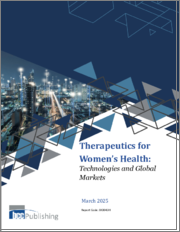
|
시장보고서
상품코드
1311151
세계의 산부인과 EHR 시장 규모 조사 및 예측 : 제품별, 용도별, 지역별 분석(2023-2030년)Global OBGYN EHR Market Size study & Forecast, by Product by Application, and Regional Analysis, 2023-2030 |
||||||
세계 산부인과 EHR 시장은 2022년 약 16억 달러로 평가되었고, 예측 기간인 2023년부터 2030년까지 9.50% 이상의 건전한 성장률로 성장할 것으로 예상됩니다.
산부인과 EHR(Obstetrics and Gynecology Electronic Health Record) 시장은 산부인과 의사의 요구를 충족시키는 전자 의료 기록 시장의 특정 부문을 말합니다. 의료 서비스 제공업체가 환자의 의료 기록 및 기타 의료 관련 정보를 저장, 관리 및 액세스하는 데 사용하는 디지털 플랫폼입니다. 산부인과 EHR 시장은 산부인과 의사의 고유한 요구에 맞는 특수 EHR 솔루션 개발에 초점을 맞추고 있습니다. 개인 클리닉, 병원, 여성 전문 의료 센터 등 산부인과 진료 의료 서비스 제공업체에게 서비스를 제공합니다. 이러한 EHR 시스템은 임상 워크플로우를 개선하고, 환자 치료를 강화하며, 산부인과 고유의 관리 업무를 간소화하는 것을 목표로 합니다. 산부인과 EHR 시장은 산부인과 진료소의 EHR 도입 증가, 통합 의료 솔루션에 대한 수요 증가, 디지털 의료 솔루션에 대한 세계 수요 증가 등의 요인에 의해 주도되고 있습니다.
Statista에 따르면 2020년 세계 전자건강기록(EHR) 시장 규모는 약 290억 달러였습니다. 그러나 세계 헬스케어 산업에서 EHR 시스템의 도입과 중요성이 증가함에 따라 시장 규모는 2027년까지 미화 470억 달러를 넘어설 것으로 예상되며, 향후 몇 년동안 큰 폭의 성장을 보일 것으로 예상됩니다. Statista에 따르면, 2023년 디지털 헬스 시장 매출은 1,702억 달러에 달할 것으로 예상되며, 2027년에는 시장 규모가 2,563억 달러에 달할 것으로 예상되며, 매출은 연평균 10.78(CAGR 2023-2027)로 확대될 것으로 예상되며, 2023년에는 디지털 피트니스 및 웰빙이 가장 큰 시장 카테고리를 차지하여 총 수익이 969억 4,000만 달러에 달할 것으로 예상됩니다. 산부인과 EHR 시스템을 포함한 디지털 건강 솔루션에 대한 세계 수요는 기술 발전, 효율적인 의료 서비스 제공의 필요성, 환자 결과 개선 등 다양한 요인으로 인해 크게 성장하고 있습니다. 헬스케어정보관리시스템협회(HIMSS)의 조사에 따르면, 세계 의료기관의 88%가 2022년까지 상호운용성을 달성하기 위한 전략적 계획을 수립하고 있으며, 이는 원활한 정보 교환을 촉진하는 EHR 시스템의 중요성을 강조하고 있습니다. 또한, 상호운용성에 대한 수요 증가는 EHR 벤더들이 의료진 간의 효율적인 정보 교환과 협업을 가능하게 하는 상호운용성 솔루션을 개발할 수 있는 기회로 작용할 수 있습니다. 상호운용성은 서로 다른 시스템과 소프트웨어가 데이터를 교환하고 활용할 수 있는 능력을 의미하며, 의료 산업에서 매우 중요한 요구 사항입니다. Journal of Medical Internet Research에 게재된 연구에 따르면, EHR 시스템과 통합된 환자 포털은 환자 만족도를 높이고 치료 계획 준수율을 향상시킬 수 있는 것으로 나타났습니다. 환자 만족도를 높이고, 치료 계획의 순응도를 높였으며, 환자와 의료 서비스 제공업체 간의 커뮤니케이션을 강화했습니다. 그러나 산부인과 EHR의 높은 도입 및 유지보수 비용은 2023-2030년의 예측 기간 동안 시장 성장에 걸림돌이 될 것으로 보입니다. Technology)에 따르면, 전자건강기록(EHR)의 예상 도입 비용은 선택한 EHR 시스템의 유형, 지리적 위치, 진료소 내 의사 수, 도입 과정의 기간 등의 요인에 따라 의사 1인당 15,000달러에서 70,000달러의 범위에 해당합니다.
세계의 산부인과 EHR 시장 조사에서 고려된 주요 지역은 아시아태평양, 북미, 유럽, 라틴아메리카, 중동 및 아프리카지역입니다. 북미는 EHR 사용을 장려하는 정책과 강력한 디지털 리터러시 인프라의 존재 등 주요 요인으로 인해 2022년 시장을 주도할 것으로 예상되며, 의료정보기술(HCIT) 도입에 대한 지불자 및 의료 서비스 제공업체의 지원이 개선되면 시장 성장이 가속화될 것으로 예상됩니다. Office of the National Coordinator for Health Information Technology)에 따르면, 미국에서는 2021년까지 병원의 96%, 진료실 의사의 78%가 전자 의료기록을 사용하게 될 것으로 추정했습니다. 그러나 아시아태평양은 노인 인구 증가로 인해 예측 기간 동안 크게 성장할 것으로 예상됩니다. 자원과 재정적 제약에도 불구하고, 이 지역의 의료 시스템은 높은 수준의 표준과 서비스에 대한 수요 증가로 인해 디지털화가 진행되고 있습니다. 이 지역 시장 성장을 가속하기 위해 호스피탈리티는 EHR과 같은 디지털 의료 기술에 적극적으로 투자하고 있습니다.
이 조사의 목적은 최근 몇 년간 다양한 부문과 국가 시장 규모를 파악하고 향후 몇 년간 시장 규모를 예측하는 것입니다. 이 보고서는 조사 대상 국가 산업의 질적/양적 측면을 모두 포함하도록 설계되었습니다.
또한 시장의 미래 성장을 규정하는 촉진요인과 과제와 같은 중요한 측면에 대한 자세한 정보도 제공합니다. 또한, 주요 기업의 경쟁 구도와 제품 제공에 대한 상세한 분석과 함께 이해관계자들이 투자할 수 있는 미시적 시장에서의 잠재적 기회도 포함합니다.
목차
제1장 주요 요약
- 시장 현황
- 세계 시장·부문별 시장 추산·예측, 2020-2030년
- 산부인과 EHR 시장 : 지역별, 2020-2030년
- 산부인과 EHR 시장 : 제품별, 2020-2030년
- 산부인과 EHR 시장 : 용도별, 2020-2030년
- 주요 동향
- 조사 방법
- 조사 상정
제2장 세계의 산부인과 EHR 시장 정의와 범위
- 조사 목적
- 시장 정의와 범위
- 산업 발전
- 조사 범위
- 조사 대상년도
- 통화 환산율
제3장 세계의 산부인과 EHR 시장 역학
- 산부인과 EHR 시장 영향 분석(2020-2030년)
- 시장 성장 촉진요인
- 시장이 해결해야 할 과제
- 시장 기회
제4장 세계의 산부인과 EHR 시장 : 산업 분석
- Porter's Five Forces 모델
- 공급 기업의 교섭력
- 바이어의 교섭력
- 신규 진출업체의 위협
- 대체품의 위협
- 경쟁 기업간 경쟁 관계
- Porter's Five Forces의 영향 분석
- PEST 분석
- 정치
- 경제
- 사회
- 기술
- 환경
- 법률
- 주요 투자 기회
- 주요 성공 전략
- COVID-19의 영향 분석
- 파괴적 동향
- 업계 전문가의 견해
- 애널리스트의 결론 및 제안
제5장 세계의 산부인과 EHR 시장 : 제품별
- 시장 현황
- 세계의 산부인과 EHR 시장 : 제품별, 실적, 잠재 능력 분석
- 세계의 산부인과 EHR 시장 : 제품별, 추정·예측 : 2020-2030년
- 산부인과 EHR 시장, 하위 부문 분석
- 클라이언트 서버 기반
- 웹 기반
제6장 세계의 산부인과 EHR 시장 : 용도별
- 시장 현황
- 세계의 산부인과 EHR 시장 : 용도별, 실적-잠재 능력 분석
- 세계의 산부인과 EHR 시장 : 용도별, 추정·예측2020-2030년
- 산부인과 EHR 시장, 하위 부문 분석
- 스케줄링
- 청구서 작성
- 임상 문서
- 워크플로우 관리
- 기타
제7장 세계의 산부인과 EHR 시장, 지역 분석
- 주요 국가
- 주요 신흥 국가
- 산부인과 EHR 시장, 지역별 시장 현황
- 북미
- 미국
- 제품 추정·예측, 2020-2030년
- 용도 추정·예측, 2020-2030년
- 캐나다
- 미국
- 유럽의 산부인과 EHR 시장 현황
- 영국
- 독일
- 프랑스
- 스페인
- 이탈리아
- 기타 유럽
- 아시아태평양의 산부인과 EHR 시장 현황
- 중국
- 인도
- 일본
- 호주
- 한국
- 기타 아시아태평양
- 라틴아메리카의 산부인과 EHR 시장 현황
- 브라질
- 멕시코
- 중동 및 아프리카
- 사우디아라비아
- 남아프리카공화국
- 기타 중동 및 아프리카
제8장 경쟁 정보
- 주요 기업의 SWOT 분석
- 주요 시장 전략
- 기업 개요
- InSync Healthcare Solutions
- 주요 정보
- 개요
- 재무(데이터 입수가 가능한 경우)
- 제품 개요
- 최근 동향
- Practice Fusion, Inc.
- PrognoCIS(Bizmatics, Inc.)
- WRS Health
- Infor-Med Inc.
- RevenueXL Inc.
- Greenway Health, LLC
- CureMD Healthcare
- NXGN Management, LLC
- EndoSoft LLC
- InSync Healthcare Solutions
제9장 조사 과정
- 조사 과정
- 데이터 마이닝
- 분석
- 시장 추정
- 검증
- 출판
- 조사 속성
- 조사의 전제조건
Global OBGYN EHR Market is valued approximately USD 1.6 billion in 2022 and is anticipated to grow with a healthy growth rate of more than 9.50% over the forecast period 2023-2030. The OBGYN EHR (Obstetrics and Gynecology Electronic Health Record) market refers to the specific segment of the electronic health record market that caters to the needs of obstetricians and gynecologists. An EHR system is a digital platform used by healthcare providers to store, manage, and access patient medical records and other healthcare-related information. The OBGYN EHR market focuses on developing specialized EHR solutions tailored to the unique needs of obstetricians and gynecologists. It serves healthcare providers in obstetric and gynaecological practices, including private clinics, hospitals, and specialized women's healthcare centres. These EHR systems aim to improve clinical workflows, enhance patient care, and streamline administrative tasks specific to obstetrics and gynaecology. The OBGYN EHR Market is driven by factors such as the increasing adoption of EHRs among gynaecology practices rising demand for integrated healthcare solutions, and increasing Global Demand for Digital Health Solutions.
According to Statista, in 2020, the global electronic health records (EHR) market was valued at around USD 29 billion. However, it may experience substantial growth in the coming years, with the market size expected to exceed USD 47 billion by 2027 as per the increasing adoption and significance of EHR systems in the healthcare industry worldwide. The rising demand of automation to make work easier also helps in the growth of the market. According to Statista, in 2023, it is expected that the digital health market will generate US$170.20 billion in revenue. By 2027, market volume is predicted to reach US$256.30 billion, with revenue forecast to expand at a 10.78% annual rate (CAGR 2023-2027). Digital Fitness & Well-Being will account for the largest market category in 2023, with a total revenue value of US$96.94 billion. The global demand for digital health solutions, including OBGYN EHR systems, is experiencing substantial growth, driven by various factors such as technological advancements, the need for efficient healthcare delivery, and improved patient outcomes. The Healthcare Information and Management Systems Society (HIMSS) conducted a survey that found 88% of healthcare organizations globally have a strategic plan in place to achieve interoperability by 2022, emphasizing the importance of EHR systems in facilitating seamless information exchange. Moreover, the growing demand for interoperability can present an opportunity for EHR vendors to develop interoperable solutions that enable efficient information exchange and collaboration among healthcare providers. Interoperability is the ability of different systems and software to exchange and utilize data and is a crucial requirement in the healthcare industry. Another opportunity that lies for OBGYN EHR Market is the rising focus on Patient Engagement. A study published in the Journal of Medical Internet Research found that patient portals integrated with EHR systems resulted in increased patient satisfaction, improved adherence to treatment plans, and enhanced communication between patients and healthcare providers. However, the high cost of OBGYN EHR implementation and maintenance may hamper the growth of the market during the forecast years 2023-2030. According to ONC (Office of the National Coordinator for Health Information Technology), the anticipated installation cost of electronic health records (EHR) ranges from $15,000 to $70,000 per doctor based on factors such as the specific type of EHR system chosen, the geographical location, the number of doctors within the practice, and the duration of the implementation process.
The key regions considered for the Global OBGYN EHR Market study includes Asia Pacific, North America, Europe, Latin America, and Middle East & Africa. North America dominated the market in 2022 owing to the major factors like policies encouraging the use of EHRs and the presence of infrastructure with strong digital literacy. Improved payer and healthcare provider support for HCIT (Healthcare Information Technology) adoption is anticipated to accelerate market growth. According to the Office of the National Coordinator for Health Information Technology (ONC), 96% of hospitals and 78% of physicians in office settings in the United States is using electronic health records by 2021. However, Asia Pacific is expected to grow significantly during the forecast period, because of the rising number of elderly people. Despite resource and financial constraints, the region's healthcare system is becoming more digital due to the rising demand for quality standards and services. In order to promote regional market growth, hospitals are actively investing in digital health technology like EHRs.
Major market player included in this report are:
- InSync Healthcare Solutions
- Practice Fusion, Inc.
- PrognoCIS (Bizmatics, Inc.)
- WRS Health
- Infor-Med Inc.
- RevenueXL Inc.
- Greenway Health, LLC
- CureMD Healthcare
- NXGN Management, LLC
- EndoSoft LLC
Recent Developments in the Market:
- In May 2023, ModMed expanded its products by adding aesthetic features to its EHR expanding its OBGYN package. In order to improve obstetrics and gynecological practices with cutting-edge workflows, this comprehensive solution includes electronic health records, payment systems, patient engagement, practice administration, image & inventory management, and data analysis.
- In March 2021, Harris, acquired the US-based healthcare supplier PrognoCIS, which was a part of the Bizmatics suite of software.
- In January 2021, WRS Health introduced Pediatrics-Cloud, a platform that integrates all facets of practice into a single, cloud-based platform, from appointment scheduling to revenue cycle management in order to better serve pediatricians.
Global OBGYN EHR Market Report Scope:
- Historical Data: 2020 - 2021
- Base Year for Estimation: 2022
- Forecast period: 2023-2030
- Report Coverage: Revenue forecast, Company Ranking, Competitive Landscape, Growth factors, and Trends
- Segments Covered: Product, Application, Region
- Regional Scope: North America; Europe; Asia Pacific; Latin America; Middle East & Africa
- Customization Scope: Free report customization (equivalent up to 8 analyst's working hours) with purchase. Addition or alteration to country, regional & segment scope*
The objective of the study is to define market sizes of different segments & countries in recent years and to forecast the values to the coming years. The report is designed to incorporate both qualitative and quantitative aspects of the industry within countries involved in the study.
The report also caters detailed information about the crucial aspects such as driving factors & challenges which will define the future growth of the market. Additionally, it also incorporates potential opportunities in micro markets for stakeholders to invest along with the detailed analysis of competitive landscape and product offerings of key players. The detailed segments and sub-segment of the market are explained below:
By Product:
- Client Server-Based
- Web-Based
By Application:
- Scheduling
- Billing
- Clinical Documentation
- Workflow Management
- Others
By Region:
- North America
- U.S.
- Canada
- Europe
- UK
- Germany
- France
- Spain
- Italy
- ROE
- Asia Pacific
- China
- India
- Japan
- Australia
- South Korea
- RoAPAC
- Latin America
- Brazil
- Mexico
- Middle East & Africa
- Saudi Arabia
- South Africa
- Rest of Middle East & Africa
Table of Contents
Chapter 1. Executive Summary
- 1.1. Market Snapshot
- 1.2. Global & Segmental Market Estimates & Forecasts, 2020-2030 (USD Billion)
- 1.2.1. OBGYN EHR (Obstetrics and Gynecology Electronic Health Record) Market, by region, 2020-2030 (USD Billion)
- 1.2.2. OBGYN EHR Market, by Product, 2020-2030 (USD Billion)
- 1.2.3. OBGYN EHR Market, by Application, 2020-2030 (USD Billion)
- 1.3. Key Trends
- 1.4. Estimation Methodology
- 1.5. Research Assumption
Chapter 2. Global OBGYN EHR Market Definition and Scope
- 2.1. Objective of the Study
- 2.2. Market Definition & Scope
- 2.2.1. Industry Evolution
- 2.2.2. Scope of the Study
- 2.3. Years Considered for the Study
- 2.4. Currency Conversion Rates
Chapter 3. Global OBGYN EHR Market Dynamics
- 3.1. OBGYN EHR Market Impact Analysis (2020-2030)
- 3.1.1. Market Drivers
- 3.1.1.1. Increasing adoption of EHRs among gynaecology practices
- 3.1.1.2. Rising demand for integrated healthcare solutions
- 3.1.1.3. Increasing Global Demand for Digital Health Solutions
- 3.1.2. Market Challenges
- 3.1.2.1. High Cost of OBGYN HER implementation and maintenance
- 3.1.3. Market Opportunities
- 3.1.3.1. Growing demand for Interoperability
- 3.1.3.2. Growing use of cloud-based EHR solutions
- 3.1.1. Market Drivers
Chapter 4. Global OBGYN EHR Market: Industry Analysis
- 4.1. Porter's 5 Force Model
- 4.1.1. Bargaining Power of Suppliers
- 4.1.2. Bargaining Power of Buyers
- 4.1.3. Threat of New Entrants
- 4.1.4. Threat of Substitutes
- 4.1.5. Competitive Rivalry
- 4.2. Porter's 5 Force Impact Analysis
- 4.3. PEST Analysis
- 4.3.1. Political
- 4.3.2. Economic
- 4.3.3. Social
- 4.3.4. Technological
- 4.3.5. Environmental
- 4.3.6. Legal
- 4.4. Top investment opportunity
- 4.5. Top winning strategies
- 4.6. COVID-19 Impact Analysis
- 4.7. Disruptive Trends
- 4.8. Industry Expert Perspective
- 4.9. Analyst Recommendation & Conclusion
Chapter 5. Global OBGYN EHR Market, by Product
- 5.1. Market Snapshot
- 5.2. Global OBGYN EHR Market by Product, Performance - Potential Analysis
- 5.3. Global OBGYN EHR Market Estimates & Forecasts by Product 2020-2030 (USD Billion)
- 5.4. OBGYN EHR Market, Sub Segment Analysis
- 5.4.1. Client Server-Based
- 5.4.2. Web-Based
Chapter 6. Global OBGYN EHR Market, by Application
- 6.1. Market Snapshot
- 6.2. Global OBGYN EHR Market by Application, Performance - Potential Analysis
- 6.3. Global OBGYN EHR Market Estimates & Forecasts by Application 2020-2030 (USD Billion)
- 6.4. OBGYN EHR Market, Sub Segment Analysis
- 6.4.1. Scheduling
- 6.4.2. Billing
- 6.4.3. Clinical Documentation
- 6.4.4. Workflow Management
- 6.4.5. Others
Chapter 7. Global OBGYN EHR Market, Regional Analysis
- 7.1. Top Leading Countries
- 7.2. Top Emerging Countries
- 7.3. OBGYN EHR Market, Regional Market Snapshot
- 7.4. North America OBGYN EHR Market
- 7.4.1. U.S. OBGYN EHR Market
- 7.4.1.1. Product breakdown estimates & forecasts, 2020-2030
- 7.4.1.2. Application breakdown estimates & forecasts, 2020-2030
- 7.4.2. Canada OBGYN EHR Market
- 7.4.1. U.S. OBGYN EHR Market
- 7.5. Europe OBGYN EHR Market Snapshot
- 7.5.1. U.K. OBGYN EHR Market
- 7.5.2. Germany OBGYN EHR Market
- 7.5.3. France OBGYN EHR Market
- 7.5.4. Spain OBGYN EHR Market
- 7.5.5. Italy OBGYN EHR Market
- 7.5.6. Rest of Europe OBGYN EHR Market
- 7.6. Asia-Pacific OBGYN EHR Market Snapshot
- 7.6.1. China OBGYN EHR Market
- 7.6.2. India OBGYN EHR Market
- 7.6.3. Japan OBGYN EHR Market
- 7.6.4. Australia OBGYN EHR Market
- 7.6.5. South Korea OBGYN EHR Market
- 7.6.6. Rest of Asia Pacific OBGYN EHR Market
- 7.7. Latin America OBGYN EHR Market Snapshot
- 7.7.1. Brazil OBGYN EHR Market
- 7.7.2. Mexico OBGYN EHR Market
- 7.8. Middle East & Africa OBGYN EHR Market
- 7.8.1. Saudi Arabia OBGYN EHR Market
- 7.8.2. South Africa OBGYN EHR Market
- 7.8.3. Rest of Middle East & Africa OBGYN EHR Market
Chapter 8. Competitive Intelligence
- 8.1. Key Company SWOT Analysis
- 8.1.1. Company 1
- 8.1.2. Company 2
- 8.1.3. Company 3
- 8.2. Top Market Strategies
- 8.3. Company Profiles
- 8.3.1. InSync Healthcare Solutions
- 8.3.1.1. Key Information
- 8.3.1.2. Overview
- 8.3.1.3. Financial (Subject to Data Availability)
- 8.3.1.4. Product Summary
- 8.3.1.5. Recent Developments
- 8.3.2. Practice Fusion, Inc.
- 8.3.3. PrognoCIS (Bizmatics, Inc.)
- 8.3.4. WRS Health
- 8.3.5. Infor-Med Inc.
- 8.3.6. RevenueXL Inc.
- 8.3.7. Greenway Health, LLC
- 8.3.8. CureMD Healthcare
- 8.3.9. NXGN Management, LLC
- 8.3.10. EndoSoft LLC
- 8.3.1. InSync Healthcare Solutions
Chapter 9. Research Process
- 9.1. Research Process
- 9.1.1. Data Mining
- 9.1.2. Analysis
- 9.1.3. Market Estimation
- 9.1.4. Validation
- 9.1.5. Publishing
- 9.2. Research Attributes
- 9.3. Research Assumption

















